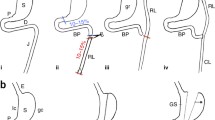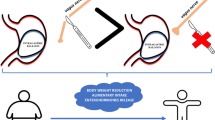Abstract
Background
Bariatric surgery is currently the only anti-obesity therapy that can deliver weight loss of up to 20–30% of body weight. Laparoscopic adjustable gastric banding (LAGB) and Roux-en-y gastric bypass are the most commonly performed of these surgeries. The mechanisms by which LAGB initiates an increase in satiety remain completely unknown. The aim of this study is to establish a rodent model of adjustable gastric banding (AGB) that will enable investigation of these mechanisms.
Methods
Sprague–Dawley rats were implanted with adjustable gastric bands immediately below the gastro-esophageal junction around the glandular stomach. This band, as in humans, can be inflated via an exteriorized port resulting in an incremental impact on the stomach.
Results
Rats with an incremental inflation of the AGB showed a clear stepwise reduction in food intake and body weight. Normal food intake and body weight gain were restored with band deflation. Barium-assisted X-ray of the stomach showed the formation of a small gastric pouch proximal to the inflated band in a manner analogous to the human LAGB.
Conclusions
This is the first animal model of the AGB that allows incremental inflation for optimal tightening of the band in the conscious animal with corresponding effects on food intake and body weight. This model will allow measurement of acute and chronic neural and hormonal changes following activation of the band in the conscious animal and will provide the potential to inform and improve surgical approaches that are at the forefront of obesity treatments.





Similar content being viewed by others
References
Curioni CC, Lourenco PM. Long-term weight loss after diet and exercise: a systematic review. Int J Obes (Lond) 2005;29:1168–74.
Douketis JD, Macie C, Thabane L, et al. Systematic review of long-term weight loss studies in obese adults: clinical significance and applicability to clinical practice. Int J Obes (Lond) 2005;29:1153–67.
Padwal R, Li SK, Lau DC. Long-term pharmacotherapy for overweight and obesity: a systematic review and meta-analysis of randomized controlled trials. Int J Obes Relat Metab Disord 2003;27:1437–46.
O’Brien PE, McPhail T, Chaston TB, et al. Systematic review of medium-term weight loss after bariatric operations. Obes Surg 2006;16:1032–40.
Adams TD, Gress RE, Smith SC, et al. Long-term mortality after gastric bypass surgery. N Engl J Med 2007;357:753–61.
Dixon JB, O’Brien PE. Changes in comorbidities and improvements in quality of life after LAP-BAND placement. Am J Surg 2002;184:51S–4S.
Peeters A, O’Brien PE, Laurie C, et al. Substantial intentional weight loss and mortality in the severely obese. Ann Surg 2007;246:1028–33.
Chapman AE, Kiroff G, Game P, et al. Laparoscopic adjustable gastric banding in the treatment of obesity: a systematic literature review. Surgery 2004;135:326–51.
Dixon JB, O’Brien PE, Playfair J, et al. Adjustable gastric banding and conventional therapy for type 2 diabetes: a randomized controlled trial. JAMA 2008;299:316–23.
Naslund E, Kral JG. Patient selection and the physiology of gastrointestinal antiobesity operations. Surg Clin North Am 2005;85:725–40. vi.
Schwartz MW, Woods SC, Seeley RJ, et al. Is the energy homeostasis system inherently biased toward weight gain? Diabetes 2003;52:232–8.
Aylwin S. Gastrointestinal surgery and gut hormones. Curr Opin Endocrinol Diabetes 2005;12:89–98.
Vincent RP, le Roux CW. Changes in gut hormones after bariatric surgery. Clin Endocrinol (Oxf) 2008;69:173–9.
Greenway SE, Greenway FL 3rd, Klein S. Effects of obesity surgery on non-insulin-dependent diabetes mellitus. Arch Surg 2002;137:1109–17.
Dixon AF, Dixon JB, O’Brien PE. Laparoscopic adjustable gastric banding induces prolonged satiety: a randomized blind crossover study. J Clin Endocrinol Metab 2005;90:813–9.
Monteiro MP, Monteiro JD, Aguas AP, et al. A rat model of restrictive bariatric surgery with gastric banding. Obes Surg 2006;16:48–51.
Endo Y, Ohta M, Kai S, et al. An obese rat model of bariatric surgery with gastric banding. Obes Surg 2007;17:815–9.
Gannon B, Browning J, O’Brien P. The microvascular architecture of the glandular mucosa of rat stomach. J Anat 1982;135:667–83.
Browning J, Gannon BJ, O’Brien P. The microvasculature and gastric luminal pH of the forestomach of the rat: a comparison with the glandular stomach. Int J Microcirc Clin Exp 1983;2:109–18.
Rokicki W, Rokicki M, Rokicki W Jr. The original experimental model in rats to study gastric banding surgery. Obes Surg 2008;18:686–9.
DeMaria EJ, Sugerman HJ, Meador JG, et al. High failure rate after laparoscopic adjustable silicone gastric banding for treatment of morbid obesity. Ann Surg 2001;233:809–18.
Brown WA, Burton PR, Anderson M, et al. Symmetrical pouch dilatation after laparoscopic adjustable gastric banding: incidence and management. Obes Surg 2008;18:1104–8.
Author information
Authors and Affiliations
Corresponding author
Rights and permissions
About this article
Cite this article
Kampe, J., Brown, W.A., Stefanidis, A. et al. A Rodent Model of Adjustable Gastric Band Surgery—Implications for the Understanding of Underlying Mechanisms. OBES SURG 19, 625–631 (2009). https://doi.org/10.1007/s11695-008-9751-0
Received:
Accepted:
Published:
Issue Date:
DOI: https://doi.org/10.1007/s11695-008-9751-0




